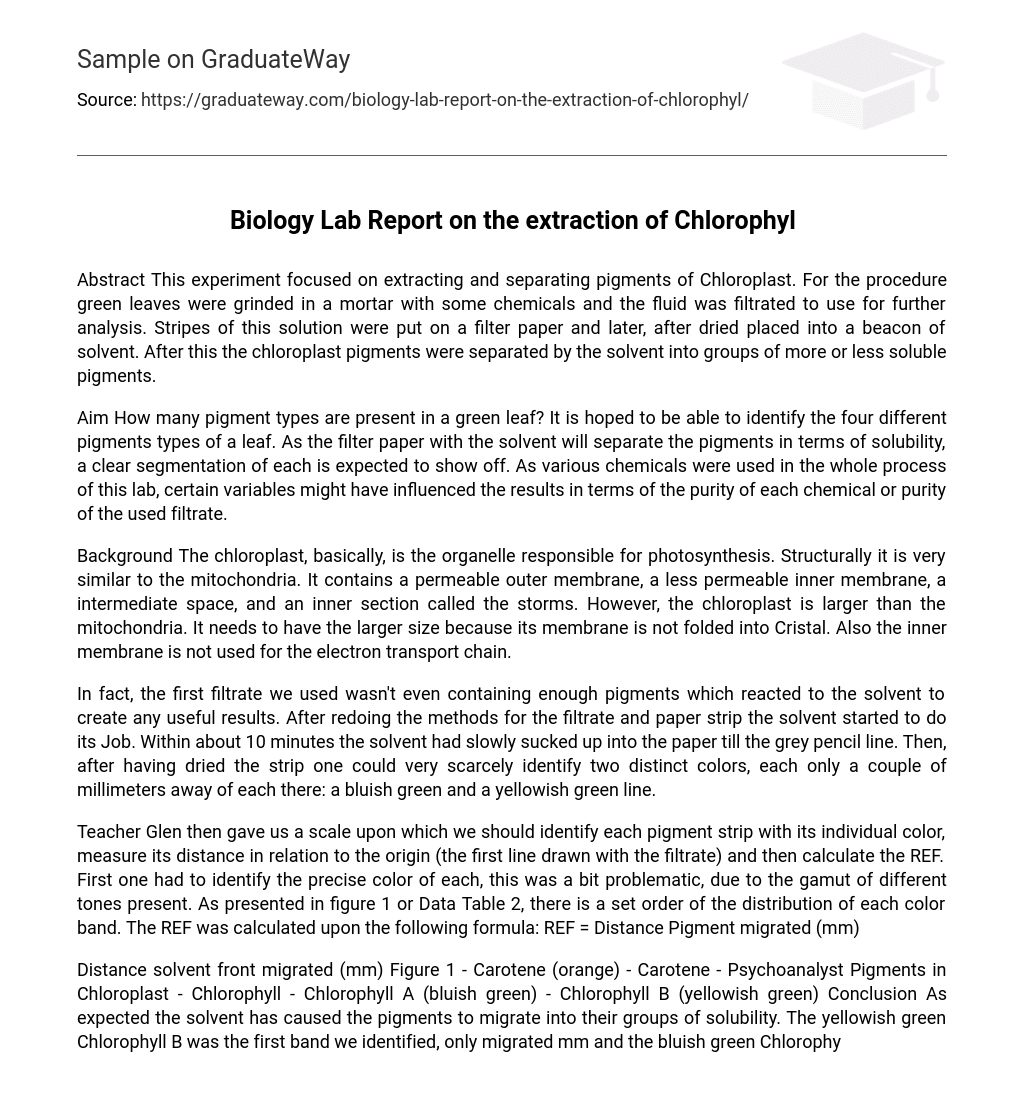Abstract This experiment focused on extracting and separating pigments of Chloroplast. For the procedure green leaves were grinded in a mortar with some chemicals and the fluid was filtrated to use for further analysis. Stripes of this solution were put on a filter paper and later, after dried placed into a beacon of solvent. After this the chloroplast pigments were separated by the solvent into groups of more or less soluble pigments.
Aim How many pigment types are present in a green leaf? It is hoped to be able to identify the four different pigments types of a leaf. As the filter paper with the solvent will separate the pigments in terms of solubility, a clear segmentation of each is expected to show off. As various chemicals were used in the whole process of this lab, certain variables might have influenced the results in terms of the purity of each chemical or purity of the used filtrate.
Background The chloroplast, basically, is the organelle responsible for photosynthesis. Structurally it is very similar to the mitochondria. It contains a permeable outer membrane, a less permeable inner membrane, a intermediate space, and an inner section called the storms. However, the chloroplast is larger than the mitochondria. It needs to have the larger size because its membrane is not folded into Cristal. Also the inner membrane is not used for the electron transport chain.
In fact, the first filtrate we used wasn’t even containing enough pigments which reacted to the solvent to create any useful results. After redoing the methods for the filtrate and paper strip the solvent started to do its Job. Within about 10 minutes the solvent had slowly sucked up into the paper till the grey pencil line. Then, after having dried the strip one could very scarcely identify two distinct colors, each only a couple of millimeters away of each there: a bluish green and a yellowish green line.
Teacher Glen then gave us a scale upon which we should identify each pigment strip with its individual color, measure its distance in relation to the origin (the first line drawn with the filtrate) and then calculate the REF. First one had to identify the precise color of each, this was a bit problematic, due to the gamut of different tones present. As presented in figure 1 or Data Table 2, there is a set order of the distribution of each color band. The REF was calculated upon the following formula: REF = Distance Pigment migrated (mm)
Distance solvent front migrated (mm) Figure 1 – Carotene (orange) – Carotene – Psychoanalyst Pigments in Chloroplast – Chlorophyll – Chlorophyll A (bluish green) – Chlorophyll B (yellowish green) Conclusion As expected the solvent has caused the pigments to migrate into their groups of solubility. The yellowish green Chlorophyll B was the first band we identified, only migrated mm and the bluish green Chlorophyll A migrated mm. This told us that there was only Chlorophyll present in the green leave, although other students who had performed this experiment as well achieved different results.
The only issue which could be mentioned about the overall lab design is the rooms’ ventilation system. After having opened the bottle with the solvent, within only a couple of minutes the whole room had a very intense smell which made a few students feel dizzy or get a headache. There are no real suggestions for this problem, except talking to the schools maintenance crew and tell them to get the fans fixed. The reasons for the strange results could only be derived due to the fact, that maybe the chemicals used for this experiment weren’t pure enough, as well as the self made filtrate.





